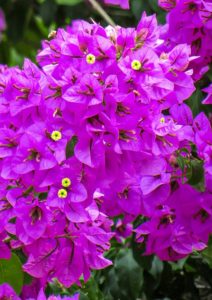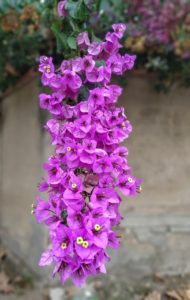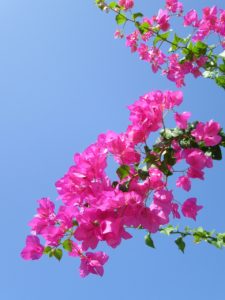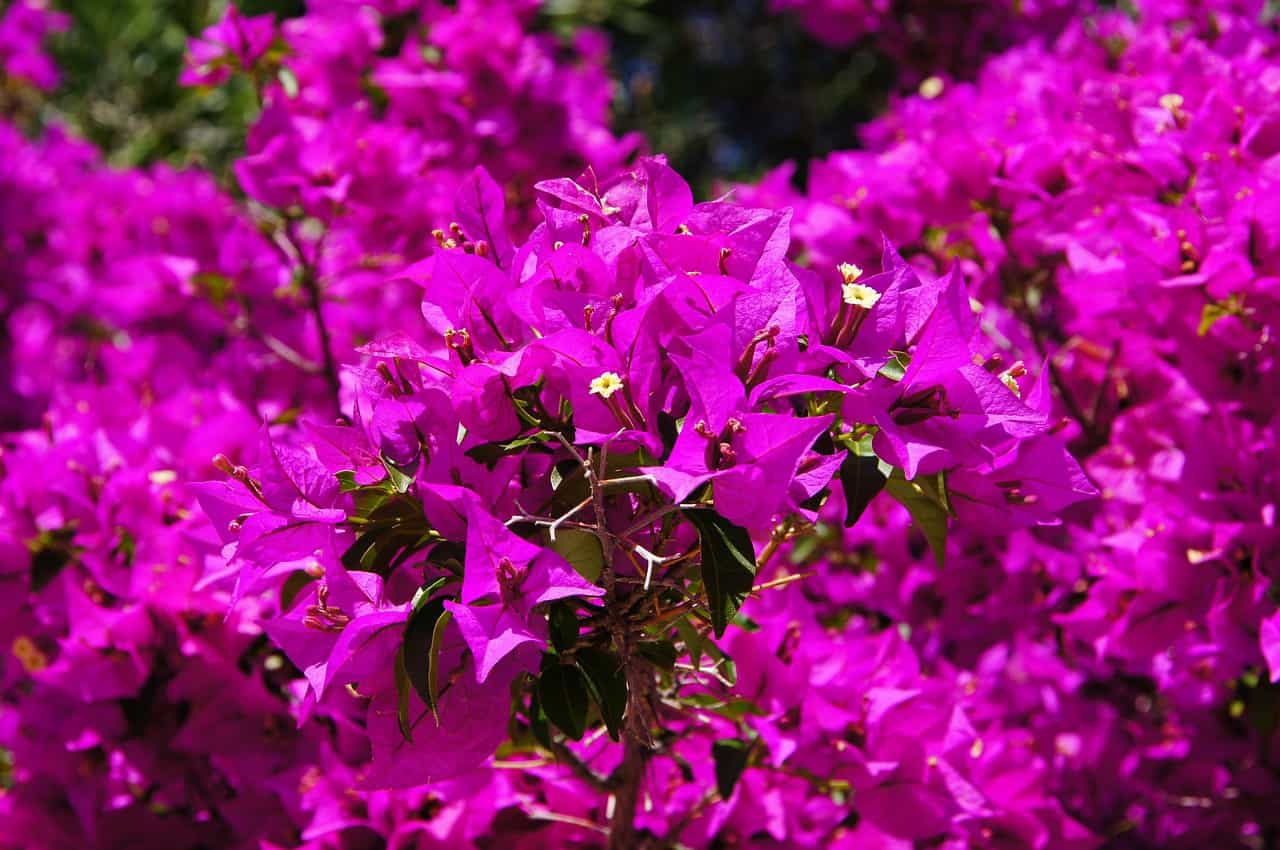Some links in the post are affiliate links and I get a commission from purchases made through some links found in the post.
Most people, even if they are not avid gardeners, will have seen bougainvillea somewhere when it is blooming.
Not only do bougainvillea look magnificent when in full bloom, they keep blooming for a decent amount of time.
Bougainvillea make wonderful hedges. They are classed as perennial vines and can grow up to 30’ depending on the type.
Sadly, as many gardeners myself included) have found out, these beautiful plants have long, sharp thorns which will ensure you pay the price for pruning them!
Having brought your new bougainvillea home from the garden centre and planted it, you may be concerned at the lack of blooms.
Many new gardeners ask the question about how to keep their bougainvillea blooming and you may be surprised at the answers.
Some Factors Which Influence Your Bougainvillea
Light and Wind
Your bougainvillea loves the sun! In fact, they almost demand the sun to reward you with blooms.
Direct sunlight is where you need to place them for maximum bloom and the minimum they will be happy with is five hours per day.
The general rule with these plants is that the more sun they get, the more they will flower.
Less sun and more shade will give you a plant with just green foliage.
Just as they enjoy the sun, so they like less wind. They are not too happy with frost and cold, so if you want flowers, then pay attention to where you plant them.
Check the Dryness
 The best conditions for bougainvillea to thrive is are arid conditions.
The best conditions for bougainvillea to thrive is are arid conditions.
This is why they are so popular in places like Mexico, and where I live in southern Spain. We can guarantee a hot dry summer, and that’s what they love.
If you plant is lacking in flowers then look at your watering schedule. This is particularly important if the rest of your garden is on an irrigation system.
You may want to remove the irrigation from the bougainvillea and water by hand when needed.
If you want to stimulate blooming then you can withhold water until the leaves start to wilt and then give them a deep water.
For a regular watering routine, you need only water them when the soil is dry and before the leaves begin to wilt.
If you have moved into a new house and have one of these plants, the chances are it is well established and therefore require little watering.
Watch the Soil
Bougainvillea love soil which few other plants will tolerate. Soil that is low in nutrients will suit them well, thank you very much. If you give them too much fertilizer you will see more foliage than flowers.
The preferred soil is slightly acidic although they will appreciate a mixture of peat moss and soil when you first plant them.
Once you have planted your new bougainvillea you can simply leave them alone. They will need to rest after being planted but it does not take long before they are nicely settled.
Check your Pruning
Another reason why your bougainvillea is not flowering may be because of incorrect pruning. While vigorous pruning will increase flowers, if done at the wrong time, it will decrease flowering.
Never prune excessively in the spring because the flowers form on new wood. Fall or winter pruning is best to encourage new growth.
After you have done the hard prune in fall or winter, restrict your pruning to simply cutting off a few unwanted tips here and there.
Here’s a tip: wear heavy gloves when you prune because the thorns can be nasty. We have an article on best ladies gardening gloves in which you can find the best thornproof gloves to protect your hands here.
What Works as a Bougainvillea Bloom Booster?
There are several ways to boost your bougainvillea and encourage more blooms.
Fertilizer
Do this during the growing season if you want it to work well. Ideally make use of a good quality slow-release fertilizer. For bougainvillea which are kept in pots you should give this at half strength.
A balanced mix of nitrogen, phosphorus and potassium in a 5/5/5 ratio will promote blooming. A mixture which is too rich in nitrogen will promote growth but there will be far less flowers.
Epsom Salts
Here’s another way to give your bougainvillea a boost. Dissolve a tablespoon of Epsom Salts in a gallon of water and water deeply.
Coffee Grounds
Because bougainvillea love acidic soil, adding coffee grounds to the soil around them encourages flowers. Coffee grounds contain nitrogen which will keep your plant blooming.
If you are not a coffee drinker, you will be able to ask for used grounds from a local coffee shop.
How do you Increase Bougainvillea Flowering?
The tried and tested way to increase your bougainvillea’s flowering is to restrict the water you give it.
Your bougainvillea will be at its best when it is left for extended periods with no water.
Once the leaves start to wilt, give your plant a thorough water and it will reward you with loads of blooms!
When Should Bougainvillea be Flowering?
Your bougainvillea should be blooming between November and May.
If you have planted it is a sunny spot which gets no less than 5 hours of full sunlight per day, your plant will bloom profusely.
If you are enjoying this article, check out our article on what flowers only bloom once a year & once every 100 years
Why is Your Bougainvillea not Flowering?
Too Much Water
 The main reason for your bougainvillea to not flower is because it is getting too much water.
The main reason for your bougainvillea to not flower is because it is getting too much water.
All the plants which are grown to supply garden centres are literally starved of water so that when we visit the centres we see them at their very best – in full bloom.
Unfortunately, many people are too kind to their new bougainvillea and may even kill it with kindness when they bring it home.
Not Enough Sunlight
Once you have picked out the spot (full sun) and transplanted your new plant you should resist the temptation to nurture it and leave it alone.
Partial shade may also be a reason for the lack of blooms. You must be able to offer your plant at least 5 hours of full sunlight each day.
Any less, and while you will still have a lush green plant, you will have less blooms.
Overfeeding
Overfeeding will also play a part in the lack of flowers. Excessive nitrogen will promote good root growth but will not do anything to encourage your bougainvillea to be blooming.
Heavy Pruning
If you need to do a heavy prune then make sure you do it after the plant has bloomed. Pruning during the flowering season will reduce the number of flowers on the plant.
If your plant is getting out of control and you need to cut it back, do it carefully and only remove what you can.
If you cannot have a large bougainvillea in the area then consider changing it for a dwarf variety.
Repotting
This may sound odd at first, but your bougainvillea does not like to be pampered! In fact, it thrives on neglect!
When you pop it into a new pot you will most likely add new potting mix.
Not only have you improved the soil, but you have also given the roots more place to grow – both things your bougainvillea does not like!
As with any other pot plant you will need to repot eventually but be aware that doing this with your bougainvillea will mean less flowers until it settles down.
Common Issues and How to Fix Them
As with any other plants there are some things which are recognised as problematic areas. Bougainvillea are no different.
Aphids
While bougainvillea can resist a small infestation, if it gets too big it can damage the plant because aphids suck out the plant fluids.
Insecticidal soap and Neem oil can limit and control the infestation
Fungal Leaf Spot and Bacteria
For this to take place the conditions must be right, and the leaves have excess moisture on them for an extended time.
Apart from limiting the water, and not spraying the plants with the garden hose, you can remove the foliage which has been destroyed.
You will notice that some leaves turn a grey colour and become papery. Remove the infected parts and destroy so as not to spread the infection.
If this does not improve conditions, you can resort to chemical sprays from your garden centre.
Spider Mite
These look just like very small dots which move slowly up and down the plant.
They normally live underneath the leaves and cause damage by sucking the cells. There is often more damage when the plant gets too much water.
Dusty conditions often lead to an infestation because spider mites like dusty conditions. Sometimes it is the application of insecticide dust to kill other insects which brings on an attack of spider mites.
If you leave these alone you will find that they are naturally picked off by other insects.
Slugs and Snails
These feed on living plants as well as on decaying matter. They prefer succulent leaves, seedlings, and herbaceous plants.
You should eliminate areas which attract them such as weedy areas at the base of the plant and dense ground covers.
Make a habit of checking and trapping them – you will know they are around by the slimy trail they leave.
Caterpillar
There is a type of caterpillar that enjoys bougainvillea, namely the bougainvillea looper. It is about 1” long and mostly feeds at night.
Your garden centre will be able to sell you Bacillus thuringiensis which works well at the early stage of the larva. It does not harm birds, insects, or humans.
We suggest you only use this as a last resort as we do not like any harm to animals.
The caterpillar stops feeding a few hours after application and will die in two days.
You must cover the plant entirely so that there are no safe spots for them to stay. Normally you will only need one application.
Final Thoughts: How to Keep Your Bougainvillea Blooming
 The secret then, to a profusely blooming bougainvillea is not to nurture it.
The secret then, to a profusely blooming bougainvillea is not to nurture it.
Keep an eye for bugs and fungus and then leave your plant to take care of itself.
Contrary to how you would take care of other plants, the bougainvillea – if you neglect it – will reward you with beautiful blooms for many months.
Before you go, here are some more related articles I encourage you to read below to help solve more of your gardening issues:
What do you do With Amaryllis Bulbs After They Bloom
Is Celosia Dragon’s Breath an Annual or Perennial
Written by: Valerie Holyoak

